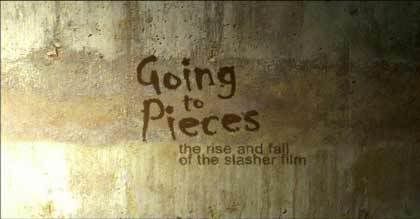Given the intrusion of a p/t dayjob into my schedule I haven't been able to attend to my blog duties as much as I wish. I always feel a bit guilty whenever I throw up another chapter of 250 Words or another Brick Bronson excerpt since I inevitably do so out of pure laziness, either unable or unwilling to create anything original at the moment. But the thing I feel guiltiest about has been how I've seemed to have abandoned my Sunday Horror Movie DVD Index posts. Trust me this is not the case. I assure you that on each of the previous three Sundays since I last discussed Jason Goes To Hell I seriously attempted to write another entry, only to give up before I had anything postable, cursing myself as I did. Today, however, I am resolved. I will not waver. I WILL stand strong.
And such is the breadth and the depth of my fortitude this balmy night, I have decided to make up for my past lethargy by discussing not one, but two different films this week. The first is a recent documentary about the slasher genre and the second is a mid-eighties post-modern deconstruction of the genre that pre-dates Scream by a full decade.
First up then is:
Based on the book by Adam Rockoff of the same name, Going to Pieces is a highly entertaining look at the slasher genre, albeit one with some annoying technical flaws and a distinct lack of depth, which is a problem many filmmakers face when dealing with such a potentially large subject in less than 90 minutes of running time. In the case of projects like this the hardest choice a director has to confront is whether or not they are making the film based on the assumption that the audience is completely ignorent of the subject or if they are making it for fellow genre scholars who already possess a firm grasp of the basics and who are looking for something more than what they already know. In the end most folks in this position decide to take the safest course and play it down the middle, assuming that their audience will be evenly split between naifs and experts, but they do so at the risk of alienating both kinds of viewers, rather than just one or the other, which is the benefit of the more direct approach. In attempting to play both sides, Going to Pieces does a better job introducing new horror fans to the genres quirks and simple, nasty pleasures than it does providing jaded oldtimers such as myself with insights we have not yet discovered on our own.
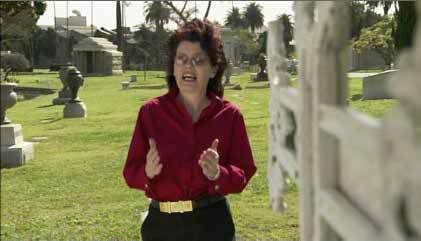

Perhaps the most damning evidence of its failure to go beyond the surface of its subject matter is the fact that not once is Carol J. Clover mentioned in the course of the film. Several of the folks who are interviewed in the film use phrases she created in her book Men, Women and Chainsaws (most specifically "Final Girl", a term everyone now uses for the female protagonists of the genre that did not exist before Clover invented it) and discuss concepts and ideas she has explored in her work, but she herself is never brought up or talked about, which is so odd considering she was the first serious academic to propose that not only was the genre not necessarily misogynistic, but that it in some cases it actually provided far more healthy and worthwhile portraits of young women than contempory non-genre films. I'm not saying the filmmakers should have spent all of the movie discussing her ideas, but I don't think it is too much to expect that she be named at one point during the brief moments they do come up.
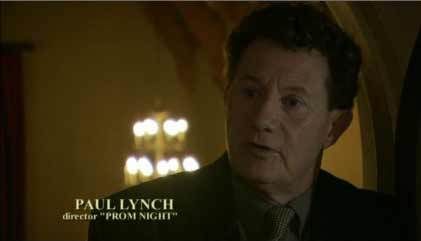
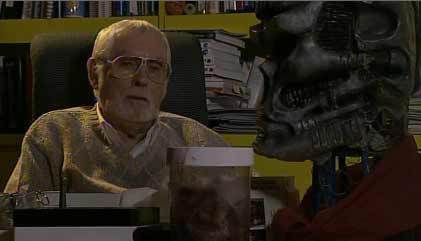
That said, the film definitely serves as a boon for trivia fanatics, especially once it gets past the exhaustively documented Halloween and Friday the 13th and starts talking about some of the more obscure movies from the period. As I watched the movie I was reminded of films I either had never seen or hadn't seen in years and I started keeping a mental list of which ones were currently available at my local genre video store for me to rent (Prom Night, Return to Horror High) and which ones I would have to search for online (Happy Birthday to Me, Graduation Day). Added to this was the delight in discovering that assumptions I had made about certain films ("In fact the film's setting is so unusual, that one cannot help but assume that it was chosen only to credibly provide an excuse for its maniac killer to don his effectively unsettling miner costume of dark overalls, gasmask, flashlight helmet and pick-ax," I wrote in my look at My Bloody Valentine) were 100% correct, and the equally enjoyable discovery that others weren't (not only did J. Lee Thompson not consider his work on Happy Birthday To Me slumming it, but he actually had to be restrained from making the film more violent than its gory script already called for).
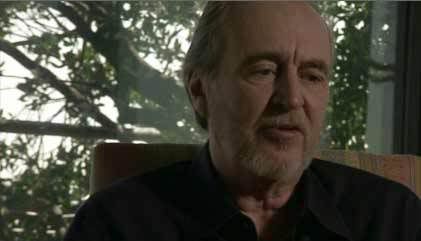
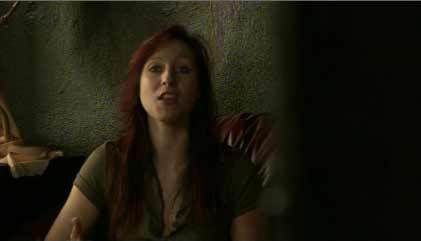
Often times the most interesting tidbits are only alluded to, rather than spelled out, such as the moment when the director of 1981's Graduation Day is identified as Rabbi Herb Freed, which adds an interesting touch to comments we had seen him make earlier before we were told who he was. But as interesting as this is, it also brings up the film's most frustrating problem, which is the randomness with which its interview subjects are identified. Some people are identified the first time we see them, some only after we have seen them several times and some not at all. There is no logical reason why, for example, Armand Mastroianni (the director of He Knows You're Alone) should be identified twice during his brief appearances in the film, while Fred Walton (the director of April Fool's Day) isn't identified at all during his. It is simply a case of sloppy filmmaking in an otherwise extremely professional production.


As a whole, Going to Pieces is a very fun, enjoyable film, but one that isn't likely going to change anyone's mind about the slasher genre. Acolytes will find much to enjoy, while those that still regard it as barely above (or even below) the level of pornography won't be exposed to anything that will correct their misconception, which is a shame, since I think it can be done.
When people start talking about the introduction of metatextuality into the horror genre, they frequently name Wes Craven's Scream as the first of it's kind. In Scary Movies I suggested that this did a disservice to New Nightmare, a previous Craven work that was easily as innovative as its predecessor, but in retrospect I think the film that is really being ripped off is a certain 1986 movie whose whole raison d'etre was clearly alluded to in its title, but which still managed to alienate audiences to such a degree that the documentary discussed above actually suggests it was partially responsible for the demise of the slasher movie genre.
Of course, I'm talking about:
Watching it now it is easy to appreciate why April Fool's Day might have pissed off slasher movie fans when it was first released, but I think the majority of the blame for this lies not with the filmmakers, but with Paramount's marketing department, who sold the film as a straight-ahead slasher movie and not the elaborate practical joke that it was actually meant to be. Of course, one can also appreciate the marketer's dilemma, since if they had sold the film for what it really was, then they would have risked giving away the climatic surprise that defines the film and makes it unique amongst its ilk. This is one of those films that works best when viewed with complete ignorence and is impossible to discus it without giving the whole game away, which places me in somewhat of a dilemma of my own. The only solution I can think of to address to situation is to announce in big bold letters that what follows henceforth is an enormous
SPOILER
so don't read anything after the next two images unless you've already seen the movie or have no fucking intention of watching anything an asshole like me would recommend. You've been warned.
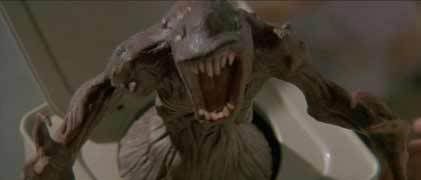
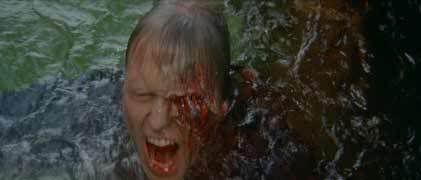
April Fool's Day is a slasher movie in which no one dies. It is the cinematic equivalent of an episode of Punk'd in which the victims are not only the characters that inhabit it, but also the audience watching them as well. What it isn't--and this is why I like it as much as I do--is a satire of the genre. Unlike such lamentable efforts as Pandemonium or Student Bodies, April Fool's Day plays its hand totally straight. That's not to say that the film isn't funny, since it frequently is, but that its humour comes from the interaction and behaviour of its characters rather than any direct or indirect references to the genre or any previous films. Rather than simply make fun of slasher movies, it is so dedicated to its purpose that it is a slasher movie right up until the moment that it proves itself otherwise.
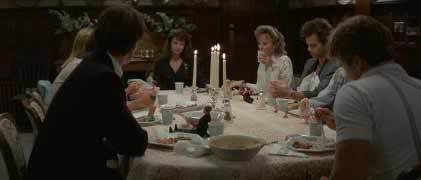
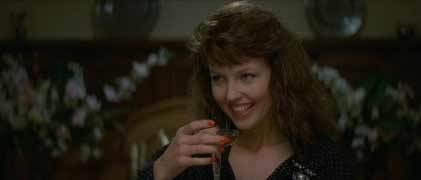
The film is set at a beautiful old house on a small island that is accesable only by a local ferry. It is there that college student Muffy St. John (an utterly adorable Deborah Foreman) has gathered together a group of friends to celebrate her inheritance of the grand old house. Amongst them are the standard slasher movie stereotypes of the slut, the bland happy couple, the ambitious go-getter, the uptight prude, the wild dude and a couple of assholes (although it is to the filmmakers' enormous credit that all of these characters manage to transcend their deliberate limitations and prove themselves to be far more compelling and likeable than the majority of their slasher movie ilk). Since the weekend gathering just happens to coincide with the start of the fourth month of the year, Muffy has fun with her guests by planting little practical jokes around the house, such as dribble glasses, exploding cigars and a spring-loaded chair that causes anyone who sits on it to land comically on the floor.
For all of her efforts to promote hilarity, a slight pall lurks over the group, since just a few hours earlier their careless shenanigans accidentally resulted in the horrible disfigurement of one of the ferry operators, who they last saw screaming as the local lawman rushed him by boat to the nearest hospital. Fortunately they eventually get over it and have a good time.
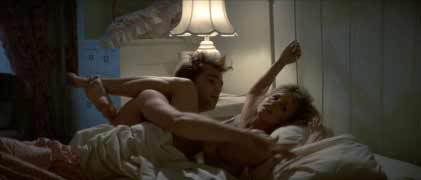
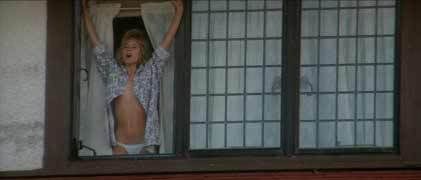
But as the night ends and everyone separates to their different rooms it soon becomes clear that Muffy--or someone else--has left far more sinister items for her guests to find. Arch (Back to the Future's Thomas Wilson) finds drug paraphenalia in his medicine cabinet, an unpleasant allusion to a past addiction. Buck, the ambitious Southerner, finds newspaper clippings about different car crashes, the suggestion clearly being that he might have been responsible for a hit & run in the past. Nikki, the sluttiest of the four girls, finds bondage gear in her room, while the reserved Nan (Made in Canada's Leah "Gordon's Daughter" Pinsent) is highly disturbed by the tape recording of a baby crying left in her room's large wardrobe cabinet, since it seems meant to cruelly remind her of the accidental pregnancy she terminated not to long ago.
And while this is all going on, Skip (second generation Hollywood fuck up Griffin O'Neal) decides to visit the marijuana plant he noticed growing wild at the beginning of the day. Having retrieved a few samples of the fragrant bud, he makes his way to the boathouse, where he is accosted by a stranger in the dark.
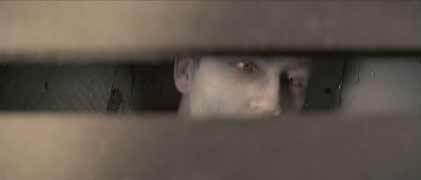
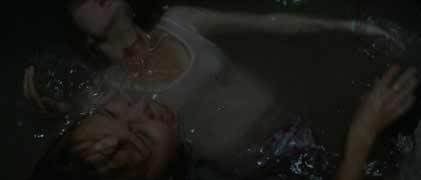
The next morning Kit and Rob, the bland happy couple, go to the boathouse to get their swerve on. It is while they are macking that Kit sees Skip's dead body floating underneath the boathouse and she--quite understandably--freaks the fuck out. Assuming that he's playing another practical joke, like the one he pulled at the ferry, the guys go out to find him, while Nan confronts Muffy about the horrible recording left in her room. Muffy, who has been acting strangely all morning, denies having anything to do with it. Arch searches for Skip in the surrounding forest, only to step into a trap which leaves him swinging upside down and menaced by a large snake, before he is approached by an even more menacing figure.
Later that day plumbing issues force Buck and Nikki to go get some water from the nearby well. When Buck drops the bucket into the water, Nikki reluctantly agrees to climb down and get it, only to discover Arch's decapitated head and Nan's dead body, causing her to--quite understandably--freak the fuck out.
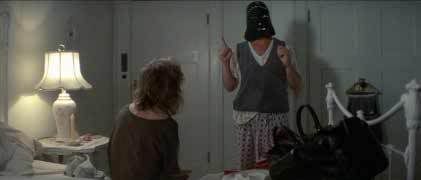
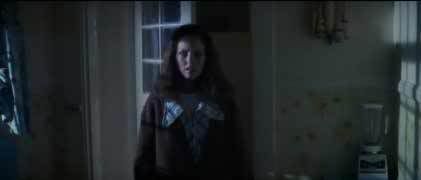
Now certain that they are trapped on an island with a deranged maniac, the surviving members of the group call the local sheriff and makes plans to escape from the deathtrap ASAP. In the time that passes before their rescue can arrive, Kit uncovers clues about a hidden piece of Muffy's past that might explain her odd behaviour and several more members of the gang are shuffled off this mortal coil in a variety of gory fashions, including one apparent castration.
Eventually Kit and Rob are the only two left and together they discover that the murderer isn't Muffy or the disfigured ferryman, but Buffy, Muffy's deranged twin sister who murdered her identical sibling during the night and took her place. The truth revealed at last, Buffy attacks the bland happy couple, managing to lock Rob in a kitchen closet, while she stalks his girlfriend with a very large and deadly looking knife. Kit does her best to elude the psychotic twin and eventually makes her way into the living room, where she is confronted by a very strange sight.
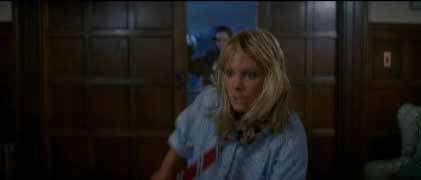
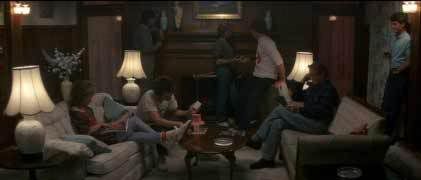
All of the dead have been resurrected. Stunned, Kit turns towards Buffy, unable to process what she is seeing. Buffy smiles and gives the whole game away with a simple gesture of the knife.
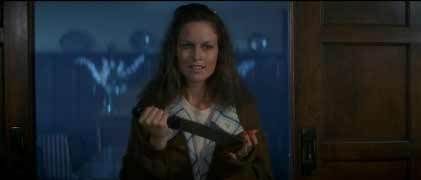
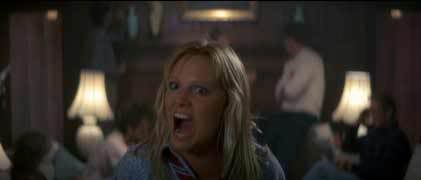
Rather than be grateful that her life isn't in danger, Kit--quite understandably--freaks the fuck out.
After Rob is also let in on the joke, Muffy--who isn't Buffy at all--explains that the whole weekend has been the test run for a murder weekend she plans on holding at the house when she turns it into a bed & breakfast, which she has to do since she promised her father that she could only live in the house if she paid for its expenses out of her own pocket. All of the various details are explained away and everyone begins to party down--the only holdout being Nan, who still seems peeved about the unfortunate referance to her abortion from the previous night.
Now, had the movie ended here, it would have been enough to make it a highly enjoyable pisstake on the slasher genre, but it is in the movie's denoument that I believe it elevates itself to something far more twisted and deeper.
Having partied hard with her friends, Muffy eventually returns to her room, a bottle of champagne still in her hand. Obviously plastered, she sits down on her bed, where she is grabbed from behind by a figure in black. It's Nan, who--apparently unable to forgive Muffy for dredging up the darkest moment of her past for the sake of a silly game--cuts her throat with a very big knife.
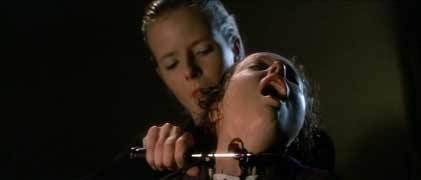
In that moment it appears that the filmmakers have acknowledged the disappointment of their audience by throwing them the bone of at least one genuine fatality. Many slasher films have featured killers who had been driven insane by lesser things than being mocked for the worst moments of their lives, so Nan's reaction, while extreme, is at least plausible by the standards of the genre. Not only that, but it provides the crucial moral element that is de rigueur in these kinds of movies--Muffy is taught the horrible lesson that sometimes it is possible for a joke to be taken too far (as we also discovered in Terror Train, Prom Night and Valentine, to name a few others off the top of my head).
Except....
They're still fucking with us.
After letting Muffy panic for a few seconds, Nan smiles and reveals that the knife is fake and the blood came from a squeeze-tube in her hand. Nan then breaks the fourth wall by turning her smile directly towards the camera, clearly indicating that her joke is just as much on us as it is Muffy.

Having duped us not once, but twice, the filmmakers take their final bow by ending the movie with a literal wink at the camera:
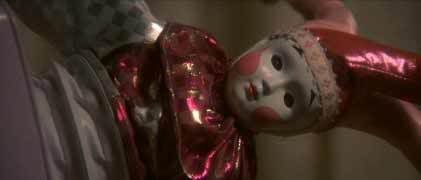
Note: Move cursor over image for full blinking action
In it's own sly, devious way, April Fool's Day is just as entertaining and thought-provoking a meta-commentary on the genre as the much more popular and heralded Scream, but unlike Craven's film, it achieves its twisted ends in a way that doesn't call attention to itself until the very end of the film. Scream screams outs exactly what it is right from the very first scene, while Danilo Bach's screenplay and Fred Walton's direction does everything it can to disguise their subversive intentions, which is probably why it managed to alienate people to a far larger degree than Scream did and why I love it as much as I do.
Slasher Statistics
Body Count: 0
Shower Scenes: 0
Instances of Nakedity: 0
Obligatory Has Beens: 0
Instruments of Death: None
Creepy (and therefore suspicious ) Old Guys: 1
References to Pot: 1
Amount of Time Required to Correctly Identify Killer: N/A
Cheesy References to Other Horror Movies: None directly, but then the entire film is a deliberate pastiche of the genre.
Utterly Pointless Trivia: Director Fred Walton remains best known for writing and directing the 1979 urban legend inspired When A Stranger Calls, which was remade into a horrible movie by Simon West last year.
Final Girl Rating: 9 out of 10
